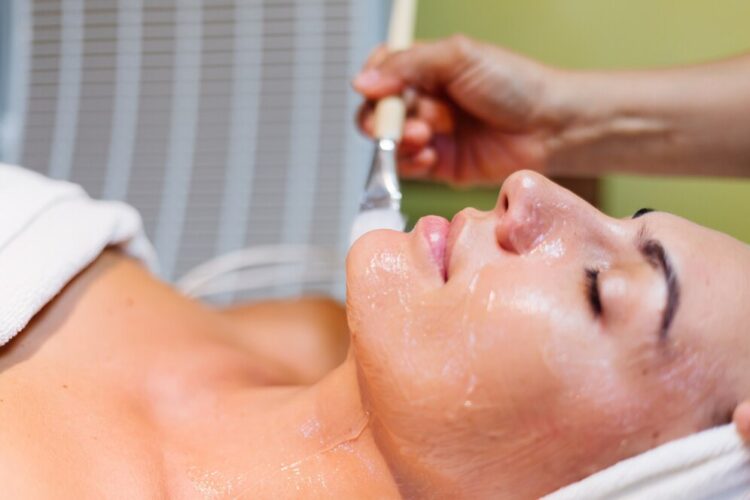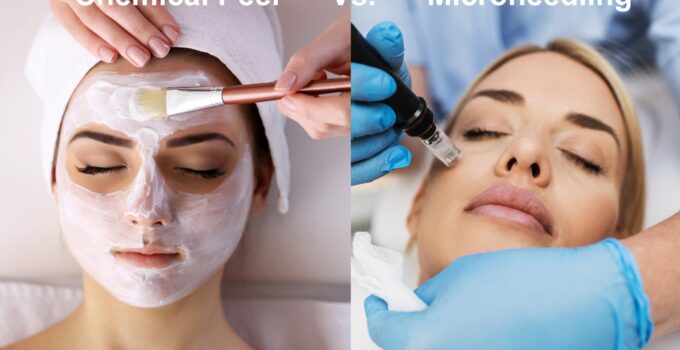A fresh, even-toned, and smooth complexion doesn’t always require surgery. Two of the most effective treatments for skin rejuvenation—microneedling and chemical peels—offer real results without dramatic downtime. But which one delivers what your skin actually needs?
Let’s break it down clearly so you can make a confident, informed decision.
Page Contents
Key Highlights
- Microneedling uses micro-injuries to activate natural skin repair.
- Chemical peels work by dissolving the top layer of damaged skin.
- Both treatments improve tone, texture, and fine lines.
- Microneedling is more suitable for deeper acne scars.
- Peels provide faster surface-level radiance.
- Choosing between the two depends on your skin goals and tolerance.
Why Skin Rejuvenation Isn’t One-Size-Fits-All

Source:freepik.com
Every person’s skin tells a different story. Some people deal with acne scars that linger for years. Others notice dullness, sunspots, or wrinkles creeping in earlier than expected. Picking a treatment that matches your skin type, history, and goals is key.
Treatments like those offered by SPBeauty are designed to meet those specific needs without surgical procedures. With expertise across Staffordshire, Tamworth, Sutton Coldfield, and Lichfield, they offer microneedling and anti-wrinkle treatments for those looking for noticeable but natural improvements. The focus is always on safe, non-invasive options.
What Happens During Microneedling
Microneedling uses fine, sterile needles to create tiny punctures across the skin’s surface. These micro-injuries don’t cause damage but instead stimulate your body’s natural repair systems.
Here’s what microneedling helps improve:
- Acne scars (especially pitted or deep ones)
- Fine lines and wrinkles
- Stretch marks
- Mild skin laxity
- Uneven texture
The process activates collagen and elastin production, which rebuilds structure and firmness in the treated area. Results aren’t instant—it usually takes 3–6 sessions to see major transformation—but the changes are long-lasting.
Expect redness for a day or two, maybe some light flaking. No major downtime needed. You can usually resume most daily activities right after, although sun exposure should be avoided.
What You Get from Chemical Peels

Source:freepik.com
Chemical peels work by applying an acid-based solution to exfoliate the top layers of skin. After treatment, the old skin peels off, revealing smoother, more radiant skin underneath.
What chemical peels are best at treating:
- Hyperpigmentation and sunspots
- Fine lines
- Mild acne
- Uneven tone
- Dull complexion
There are different intensities. Light peels use alpha-hydroxy acids (like glycolic acid). Medium and deep peels use stronger agents such as trichloroacetic acid (TCA) or phenol. The stronger the solution, the deeper the exfoliation—and the longer the recovery.
Lighter peels can be done every month with minimal downtime. Deeper peels need more recovery, often a full week or longer.
The Key Differences You Should Know
| Feature | Microneedling | Chemical Peels |
| Method | Mechanical (needles) | Chemical (acids) |
| Target Depth | Deep dermal layers | Surface to mid-dermis |
| Best For | Acne scars, texture, wrinkles | Pigmentation, brightness, fine lines |
| Pain Level | Mild discomfort | Mild to moderate (depending on strength) |
| Recovery Time | 1–2 days | 1 to 10 days (depending on depth) |
| Session Frequency | Every 4–6 weeks | Every 3–4 weeks (light peels) |
Both treatments improve skin over time, but the path to those results looks different. Microneedling builds structure. Peels refine the surface.
Who Should Pick Microneedling?

Source:freepik.com
If you’re dealing with texture issues like acne scarring or early signs of aging, microneedling is usually more effective. It reaches deeper into the skin and triggers collagen in a way that surface exfoliation can’t match.
Microneedling is also better tolerated by darker skin tones since it doesn’t carry the same risk of post-inflammatory pigmentation that strong peels might cause.
It’s ideal for:
- Acne scarring that hasn’t responded to creams
- Mild sagging or early aging
- Enlarged pores or rough skin
Your skin will gradually improve over several sessions. The boost in collagen gives your face a firmer, smoother feel with minimal risk of hyperpigmentation.
When Chemical Peels Are the Better Fit
Chemical peels shine when your main issue is tone, not texture. If your skin looks dull or shows early signs of sun damage or discoloration, a peel can reset the surface.
You’ll see improvements faster than with microneedling—often after just one session with a light peel. Medium-depth peels can even tackle moderate wrinkles and stubborn sunspots.
Ideal cases for peels:
- Uneven skin tone or sun damage
- Age spots and freckles
- Mild active acne
- Early lines and loss of radiance
But caution is needed if you have sensitive or dark skin, as the wrong acid or peel depth could trigger irritation or pigmentation issues.
Safety First: Things to Consider Before Either Treatment
Both microneedling and chemical peels are safe in the hands of trained professionals. But you need to avoid sun, stop retinoids or acids a few days before, and plan recovery time—especially after a medium or deep peel.
Here’s how to prepare smartly:
- Stop exfoliants at least 5 days before
- Don’t schedule right before events or sun exposure
- Always wear sunscreen post-treatment
- Avoid sweating or hot environments after microneedling
And make sure you’re working with a licensed provider.
Can You Combine Both?
Yes, but not at the same time.
Many dermatologists use a combination approach: peels to treat surface discoloration, microneedling for deep tissue support. Alternating them every few weeks can help address multiple skin issues at once.
But don’t mix them on your own or layer at home. Professional guidance is essential. Your provider can assess what to use, when to use it, and how to space treatments for maximum benefit.
What About Cost and Commitment?
Microneedling tends to cost more per session, but you need fewer total treatments to see lasting change. Chemical peels may cost less individually but often require regular maintenance for best results.
A rough estimate:
- Microneedling: £100–£300 per session
- Light Chemical Peels: £80–£150
- Medium Peels: £150–£300+
Long-term commitment varies too. Microneedling might only need refreshers every 6–12 months. Peels, especially lighter ones, may need monthly sessions to maintain glow.
Final Thoughts: What Should Guide Your Choice?
Your skin tells the story. You just need to listen to it.
- Choose microneedling if you want collagen, firmness, and texture repair.
- Opt for chemical peels if you want surface radiance and tone correction.
Don’t rush the choice. Consult a qualified provider. Make sure the method matches your goals, skin tone, lifestyle, and budget.
Rejuvenation isn’t about trends—it’s about what works for you




